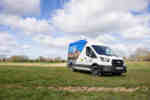A further 4,723 new vehicles in the range of 1,801-3,500kg sector had been registered in 2000 compared to 3,327 in 1999. Plans are under way for a new common-rail diesel engine to be added to the range, offering more refinement and better fuel economy. Speaking at the firm's annual 'State of the Nation' briefing, Nigel Emms, head of image and communications, said: 'There were two key words from us this time last year - optimism and realism. This year, once again, it is a message of optimism, tinged with a sense of realism.'
While the sub-3.5-tonne City Daily managed to gain a foothold in the sector in its first year of launch, he said the firm had to recognise that the van market was changing. Changes to driving licences mean that from last year, a standard car licence only entitles the driver to use a vehicle of up to 3.5 tonnes, whereas before motorists were entitled to take control of 7.5-tonne vehicles without additional training.
As a result, light commercial vans sales are shifting towards the 3.5-tonne market because companies want to be able to carry as much as possible without paying extra for drivers with extra qualifications to drive larger vans. Emms said: 'Long term, market volumes are on the way down in this segment because operators are moving towards 3.5-tonne vans. With legislation the way it is, it is only logical. As a result, overall 2.8-3.5-tonne sales fell by 6.86%, from 37,609 to 35,028. Even so, with these kind of volumes, it is still of vital importance. That is why all the manufacturers are in there, because at that size, it holds significant opportunities for all.'
















Login to comment
Comments
No comments have been made yet.